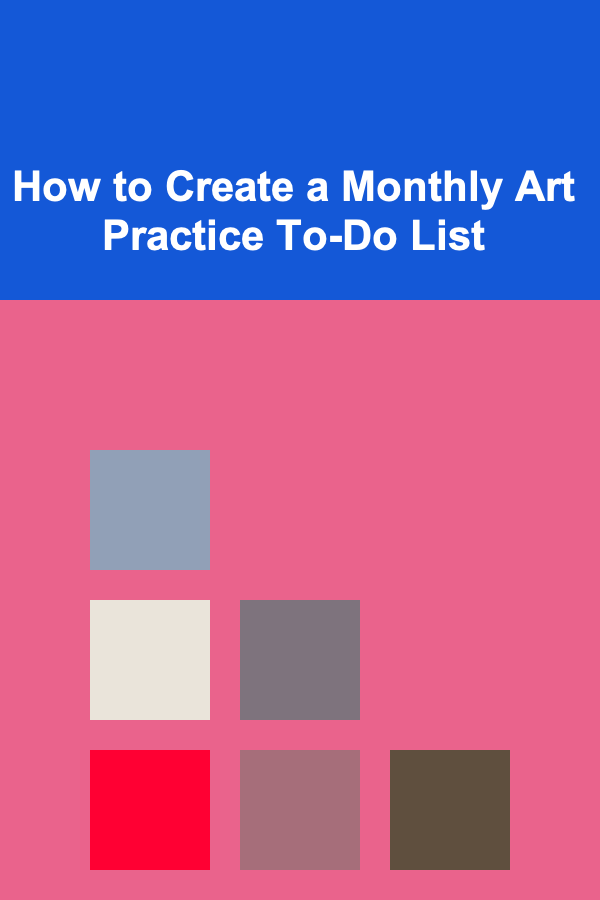
How to Create a Monthly Art Practice To-Do List
ebook include PDF & Audio bundle (Micro Guide)
$12.99$9.99
Limited Time Offer! Order within the next:

Creating an effective monthly art practice to-do list is an essential tool for any artist who wants to maintain a steady workflow, improve their skills, and stay organized. While it may seem like a simple task, a well-designed to-do list can be a game-changer for your art practice. It can provide structure, boost motivation, and ensure that you remain focused on your long-term artistic goals while managing the day-to-day demands of your creative journey.
In this article, we'll explore how to create a thoughtful and actionable monthly art practice to-do list. We will break down the process into manageable steps, offering insights and practical advice on how to tailor the list to fit your unique artistic needs.
Understand Your Artistic Goals
Before diving into the details of your monthly to-do list, it's important to establish a clear understanding of your artistic goals. Your to-do list should align with these goals and help you achieve specific milestones within your practice. Whether you're a beginner or an experienced artist, having a clear direction is key to making progress.
Identify Long-Term Goals
Ask yourself where you want your art practice to take you in the next year, five years, or even longer. Long-term goals might include mastering a particular medium, exhibiting your work in a gallery, or building an online portfolio. These goals will guide the smaller, actionable tasks that make up your monthly to-do list.
Break Down Goals into Smaller, Achievable Tasks
Once you've defined your long-term goals, break them down into smaller, more achievable objectives. For instance, if your goal is to learn oil painting, a smaller task could be to complete one study in oil each week. If your goal is to hold a solo exhibition, you can break that down into smaller tasks like finding a venue, selecting works, and promoting the event.
Plan Your Monthly Art Calendar
With your goals in mind, the next step is to organize your tasks into a structured plan. This can be done by creating a monthly calendar or a task tracker. Mapping out your art practice can help you stay on track and prevent overwhelming yourself with too many tasks at once.
Choose a Planning Tool
There are various tools you can use to create your monthly art practice to-do list. You could opt for a traditional paper planner, a digital tool like Google Calendar, or an app designed specifically for artists. Choose the method that works best for you. Digital tools offer the advantage of reminders and accessibility, while paper planners can provide a more tactile and personal experience.
Allocate Time for Art Practice
To ensure that your art practice remains consistent, dedicate specific blocks of time each week to working on your craft. This could be in the form of daily or weekly sessions, depending on your schedule and goals. By allocating time, you're more likely to stick to your practice and make steady progress.
Prioritize Tasks Based on Your Current Focus
At the start of each month, take a look at your goals and prioritize tasks that will help you move forward in your practice. While it's tempting to include everything on your to-do list, focusing on the most important tasks first will help you maintain momentum.
Focus on Skill Development
If your current focus is to develop a particular skill or technique, allocate time in your to-do list to practice specific exercises. For instance, you might dedicate time to figure drawing, mastering perspective, or experimenting with new painting techniques. Breaking down skills into smaller tasks will keep you motivated as you can see improvement over time.
Tackle Ongoing Projects
If you're in the middle of a larger project, such as a series of paintings or sculptures, prioritize completing certain phases or milestones in the process. For example, your to-do list could include tasks like "complete sketch for Series A," "finish painting background," or "start sculpting armature for final sculpture."
Include Time for Experimentation
While skill development and ongoing projects should be at the forefront of your to-do list, it's equally important to set aside time for experimentation. Experimentation is where creative breakthroughs happen, and it allows you to push boundaries and explore new ideas without the pressure of perfection.
Set Time for Play and Exploration
Dedicate a portion of your monthly art practice to exploring new mediums, techniques, or styles. Whether it's trying a different paint medium or experimenting with mixed media, the goal is to expand your artistic vocabulary and discover new ways of expressing yourself.
Keep a Sketchbook or Art Journal
A sketchbook can be a great place for experimenting and recording new ideas. Even if you don't have time for large-scale works, you can sketch, doodle, and jot down concepts or notes for future pieces. Making space for spontaneous creativity can help you stay inspired and open to new possibilities.
Set Clear, Actionable Daily and Weekly Tasks
Breaking down tasks into smaller, daily or weekly steps is key to staying productive. Having a clear, actionable plan for each day and week will prevent procrastination and ensure that you're constantly moving forward with your art.
Daily Tasks
Each day, list out what you hope to accomplish. These tasks should be small enough to complete in a single session but important enough to bring you closer to your larger goals. For instance, a daily task could be "sketch five figure poses" or "apply the first coat of oil paint to the canvas." Aim to keep these tasks manageable but essential to your practice.
Weekly Tasks
In addition to daily tasks, identify one or two larger tasks that need to be accomplished each week. This could include completing a study, starting a new painting, or reviewing and refining a previous piece. Weekly tasks should provide structure and a sense of progress as you work toward completing bigger projects.
Balance Art Practice with Self-Care
While it's important to stay dedicated to your art, you must also prioritize self-care. Art-making can be physically and emotionally taxing, and neglecting your well-being will affect your creative output in the long run.
Schedule Breaks and Downtime
Make sure to schedule regular breaks to rest your mind and body. It's easy to get caught up in the rush of completing tasks, but burnout can hinder creativity. Take time to relax, engage in activities that inspire you, or simply take a walk outside. Self-care allows you to recharge, so you can return to your practice with fresh energy and perspective.
Avoid Overloading Your Schedule
Don't overwhelm yourself with too many tasks. It's better to have a manageable list of tasks that you can complete with care and attention rather than a long list that leaves you feeling stressed. Know your limits and avoid over-scheduling.
Review and Reflect Regularly
At the end of each week or month, take the time to review your progress and reflect on your art practice. This is an essential step in ensuring that you're moving in the right direction and adjusting your goals as needed.
Evaluate Completed Tasks
Go through the tasks you've completed and evaluate the quality of your work. Are you satisfied with the results? Did you learn something new? Reflecting on your completed tasks will help you understand your growth and provide insight into areas where you may need further focus.
Adjust Your Goals and Tasks
Based on your reflections, adjust your goals or tasks for the upcoming month. If certain tasks weren't completed, determine why that happened and make adjustments to your approach. Perhaps a task was too ambitious or didn't align with your current goals. Flexibility in your practice is important to maintain a sustainable art routine.
Use Accountability to Stay Motivated
Sometimes, staying motivated can be difficult, especially when facing creative blocks or self-doubt. One way to overcome this is by setting up an accountability system.
Share Your Goals with a Supportive Network
Whether it's with friends, fellow artists, or an online community, sharing your goals can create a sense of responsibility. Having someone check in on your progress can motivate you to stay on track and push through challenges.
Track Your Progress Publicly
If you're comfortable with it, consider sharing your progress on social media or through a blog. Posting updates about your practice or completed works can create a sense of pride and encourage others to engage with your journey. Positive feedback from others can boost your motivation and inspire you to keep going.
Celebrate Your Wins, Big and Small
It's easy to focus on what's next without acknowledging the progress you've made. Celebrating your accomplishments, whether big or small, is important for maintaining a positive mindset and staying motivated.
Acknowledge Milestones
When you reach a milestone, take time to celebrate your success. Whether it's finishing a painting or mastering a technique, celebrate these achievements as they come. This reinforces the importance of your progress and reminds you of how far you've come.
Treat Yourself for Consistency
When you complete your monthly to-do list or a particularly challenging task, reward yourself. This could be as simple as taking a break to enjoy your favorite treat, or treating yourself to something special, like new art supplies. This reinforces positive behavior and makes the art-making process feel more rewarding.
Stay Flexible and Adjust as Needed
Creating an art practice to-do list isn't about rigidly adhering to every task but rather about maintaining focus and staying open to change. Flexibility is key to sustaining a long-term art practice.
Be Open to New Ideas
Throughout the month, you may come across new techniques, subjects, or inspirations. Be open to incorporating these into your to-do list. Adaptability is important as it allows your art practice to evolve.
Adjust to Life Changes
Life can sometimes interfere with your art practice, whether due to work, family commitments, or personal challenges. Don't be discouraged if you can't complete everything on your to-do list. Adjust your tasks accordingly and remember that consistency is more important than perfection.
Reading More From Our Other Websites
- [Metal Stamping Tip 101] Choosing the Right Metal: Materials Matter in Custom Stamping Projects
- [Home Budget 101] How to Organize Your Finances for Home Improvement Projects
- [Metal Stamping Tip 101] Avoid Common Pitfalls: A Designer's Checklist for Metal Stamping Success
- [Organization Tip 101] How to Create a Family Recipe Binder for Easy Cooking
- [Personal Care Tips 101] How to Choose a Body Butter with SPF for Sun Protection
- [Personal Investment 101] Building Passive Income from Deep Learning Applications in E-Commerce
- [Home Budget 101] How to Create a Home Emergency Fund to Cover Unexpected Costs
- [Home Renovating 101] How to Remodel Your Home with Energy-Efficient Appliances
- [Home Rental Property 101] How to Prepare Your Rental Property for New Tenants
- [Personal Finance Management 101] How to Pay Off Credit Card Debt Fast: Proven Methods

How to Clean and Sanitize Your Home's High-Touch Surfaces
Read More
How to Incorporate Vintage Decor into Modern Spaces
Read More
How to Use Statement Chandeliers to Elevate Your Space
Read More
How to Apply AI in Business Strategy
Read More
How to Choose the Perfect Adult Coloring Book for Your Personality
Read More
10 Tips for Integrating Mindfulness into Your Healthy Habits Planner
Read MoreOther Products

How to Clean and Sanitize Your Home's High-Touch Surfaces
Read More
How to Incorporate Vintage Decor into Modern Spaces
Read More
How to Use Statement Chandeliers to Elevate Your Space
Read More
How to Apply AI in Business Strategy
Read More
How to Choose the Perfect Adult Coloring Book for Your Personality
Read More